|
|
Post by Roquefort Raider on Aug 17, 2014 10:50:12 GMT -5
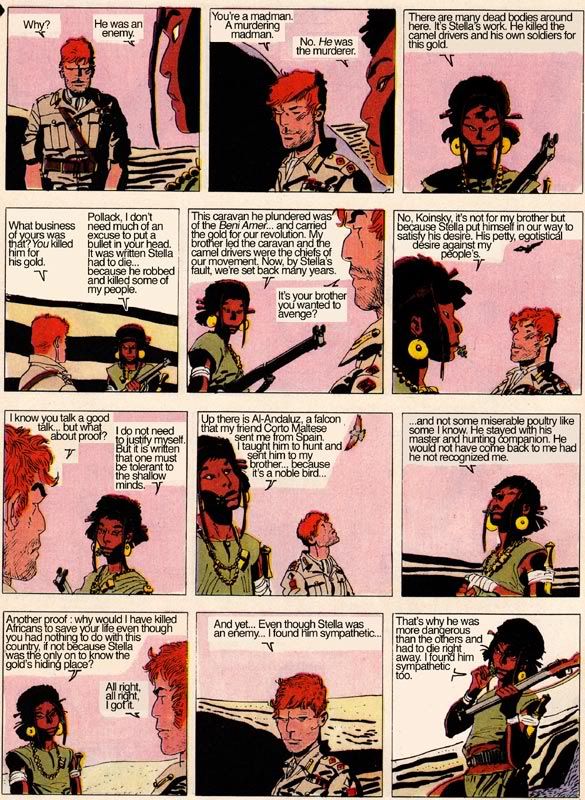 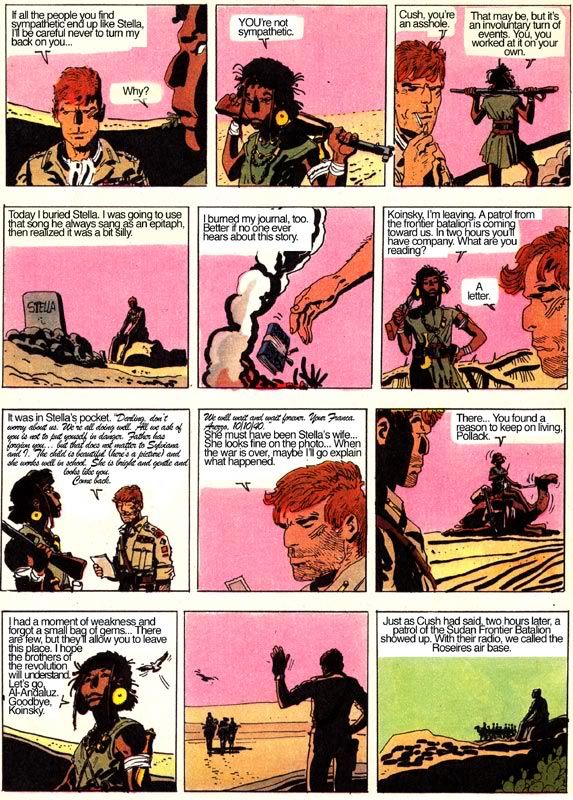 That "you're not sympathetic" line is just brilliant. |
|
|
|
Post by Roquefort Raider on Aug 17, 2014 10:53:38 GMT -5
Tintin, le journal des jeunes de 7 à 77 ansHere's a sample of what could be found in issue #15 of the 30th year of the weekly journal Tintin. It's a fair cross-section of what was happening in 1975 at the Éditions du Lombard, a Belgian powerhouse when it came to comics. Weekly comics such as Tintin were a springboard for new stories, which were then collected in albums if judged popular enough. Dupuis had the same set-up with the weekly Spirou and Dargaud with the journal Pilote. All of these journals offered a mix of adventure and humor strips. I'd say that Spirou aimed at an audience that was ever so slightly younger than Tintin, which in turn aimed at one slightly younger than Pilote. (That trend would become more apparent in the late 70s when Pilote started featuring more and more R-rated content). So, back to this issue of Tintin. This issue starts with the begining of a new Bernard Prince adventure, who is appropriately featured on the cover. Prince is a standard adventurer whose sole reason to be is to give the authors the opportunity to craft adventure yarns set in exotic locales. He used to be some kind of cop in his early days, but later on became the owner of a small boat with which he travels the world delivering what must be extremely small cargoes, considering the diminutive size of the boat. Prince is accompanied by a Captain Haddock-like sidekick, a red-headed and bearded sailor with a rotten temper and a heart of gold, as well as a serious drinking problem. With them is also a young orphan and a cub bear, both rescued in previous adventures. Bernard Prince will, in time, be embroiled in South American and African revolutions, drug traffic in northern Canada, an escape from a volcanic eruption in the southern seas, and a cleverly-mounted murder attempt in France. (The voyage aspect works, that's for sure). The script is by Greg, creator of countless quality series and ex-editor in chief of Tintin; the art is by a young Hermann who would later be known in the US as the author of Jeremiah. 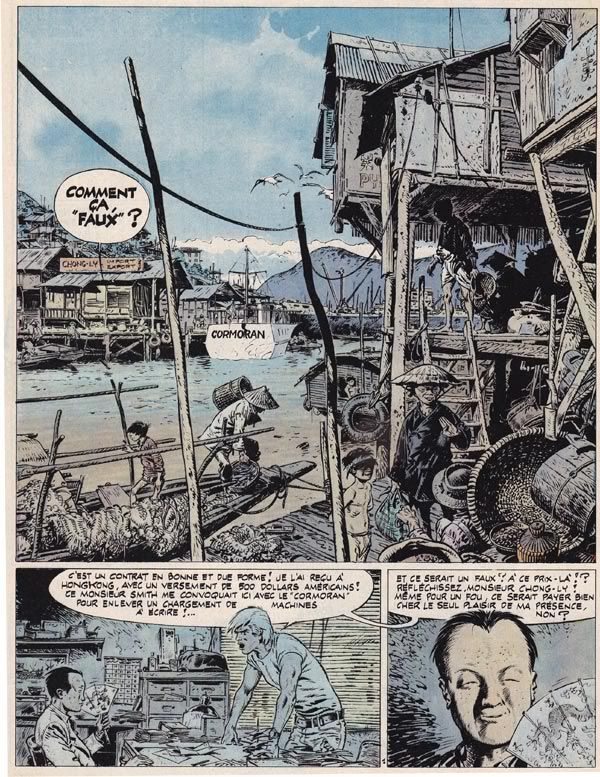 Even today I am impressed by the amount of detail Hermann puts in his work, and by the lightness and freedom of his brush work. Modeste & Pompon follow in a one-pager. These characters were handled by many different authors over the years, and they never quite developed a real personality. Here, the strip would work the same way even if it wasn't part of a series. Artist Griffo is clearly influenced by Franquin, and shows that he's quite a capable cartoonist. (The joke is kind of dated, but hey... that's from 35 years ago...) 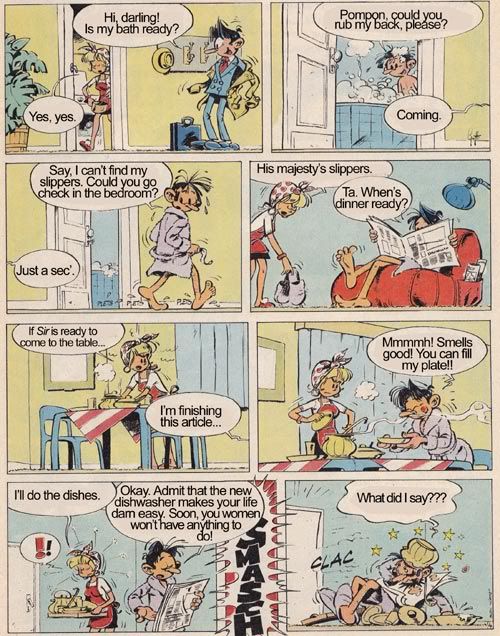 Buddy Longway Buddy Longway was in its early days as a series, as this is the end of only his third adventure. Longway is the creation of Swiss writer-artist Derib, who had a passion for drawing horses and the American west. This series would become one of the most beloved of its time, earning numerous prizes for its realistic, humanist treatment of history. It's also interesting in that it did not have a status quo that's returned to again and again; the series progressed in time just as real life does (if not necessarily in real-time). We saw Buddy Longway fall in love and marry a young Lakota, Chinook. They built a cabin and had a boy; they faced some hostile natives, some nasty white men, some cruel military officers; they also met a lot of good people from both sides of the cultural divide. They went through life, basically, as a normal family would in such conditions. Their adult son later joined an Indian rebellion and was killed; and Buddy and Chinook, tragically, finally died in a very realistic anti-climax at the hand of a violent brute with whom they had had problems in the past and who, typically, had to blame someone for his self-inflicted problems. Despite this depressing ending, this was by all accounts a great series. Here, still in the early days, Buddy and Chinook's cabin was taken over during the winter by three bandits. The family was made to work for the trio, until a falling-out caused the death of on of the crooks, and the other two left -taking the boy with them as a hostage. Buddy went after them, but so did a surprising ally : a wolf that the Longways had adopted as a cub, and who had a little while before gone back to a wild pack. As in any good Disney movie, the faithful animal had not forgotten his young friend. 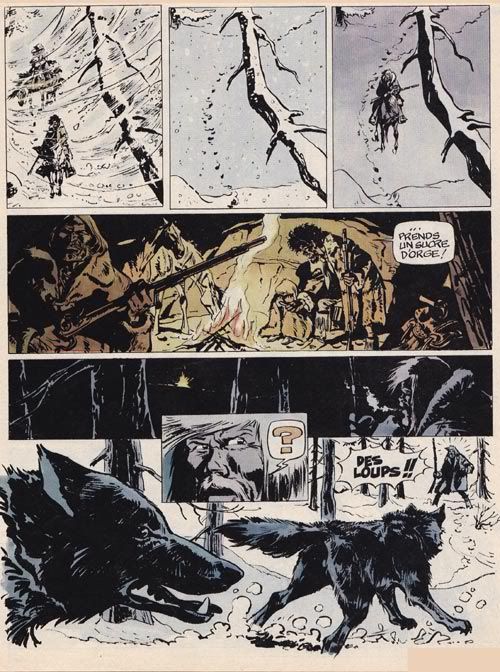
|
|
|
|
Post by Roquefort Raider on Aug 17, 2014 10:55:27 GMT -5
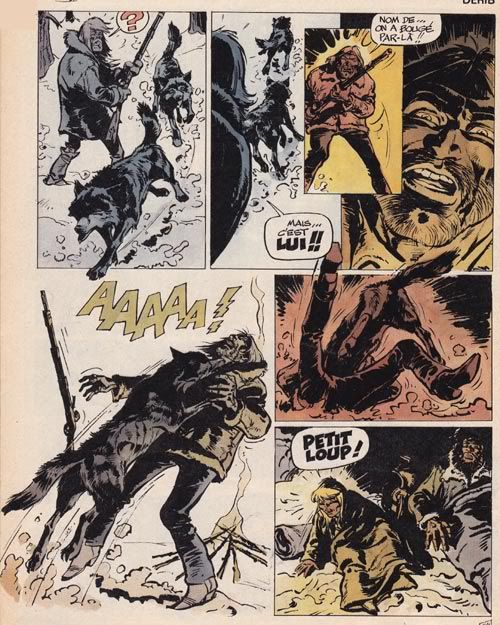 One of the great things about this series and many other like it is that they're not power fantasies or revenge fantasies. When the heroes suffer at the hands of opponents, it's not to provide an excuse for a morally-justified, cathartic revenge scene. Here, the surviving bad guy (the hairy one) is just let go without his gun. Dupa's Cubitus is next. This series, while it was quite popular with the readership in the 70s, was not particularly original and read like a minor Greg strip. Its anthropomorphic canine lead character, his mustachioed sidekick and occasional foil Radius could easily be replaced by Achille Talon, Papa Talon and neihgbor Lefuneste. Still, Dupa is a competent artist. Look at the cars depicted here: they're not "generic cars made up for a scene that requires them", they actually LOOK like european cars from the 70s. 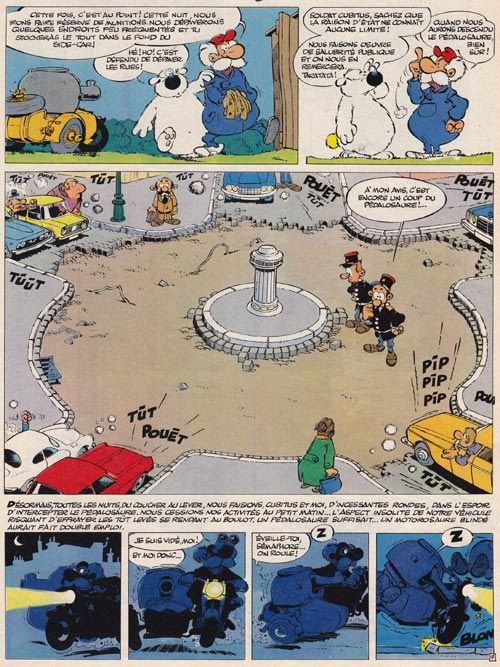 Next is another classic (and believe me, I don't keep vaunting these series out of a lack of discernment; Tintin published its share of crap over the years). Auclair's Simon du fleuve is another adventure strip for thinking readers, in which the action is an excuse for social commentary (which, thankfully, won't be overbearing during the series original incarnation and will only become so in its sequel, that was published more than a decade later). It's set in a post-modern world, à la Jeremiah, but the collapse of civilization was not due to world war III. The great economic systems of the world just collapsed, leaving us all in a state of anarchic semi-barbarism. In western Europe, a handful of big cities are under a fascistic rule and try to maintain their influence over a countryside peopled by new, small agrarian societies. The entire series is relatively short, with only six stories. The main character was introduced in "The Ballad of Red-Hair", which as far as I know was never collected in album form. Simon du Fleuve ("Simon of the River") is a loner, living off the land, but we know he's come as a child from one of the big cities where his father was a scientist. Simon holds in his hands the legacy of his dad's research: a gun that's the sole example of its kind, and which could prove disastrous in the hands of the masters of the cities should they reverse-engineer it. The only way to destroy the weapon for good, apparently, is to take it back to a lab in city N.W.#3 and to insert a certain key into it. (Why the gun can't simply be melted down is unexplained; pehaps it would blow up the countryside). In a kiddie comic, this gun would of course be Simon's "secret power", which he would use at crucial moments; here, it's really what it's said to be : a menace, a hindrance, and the reason Simon must one day go back to the city. In the first story, Simon helps an old man find his son in a town ruled by a gang of hoodlums who act as enforcers for the masters of the cities. The second story has Simon encounter a clan of people who live on horseback, Mongol-like, "The Clan of the Centaurs". There he will fall in love with the daughter of a man who happens to have known him as a child, an old colleague of his father's. But Simon will clash with the leader of the clan who also loves the girl : he will accept a formal challenge and be defeated and exiled. Shortly after his exile, he learns that the clan was attacked by an armed group sent by the masters of the city, who needed manpower for a huge smelting complex. The third story, from which this page is exerpted, is titled "The slaves" and shows how Simon and a pair of Centaur survivors follow the trail of the captives, find the smelting complex, and organize a rebellion. Here, the two Centaurs and a female companion bravely accept to be taken in as slavesso that they can get word inside the complex). 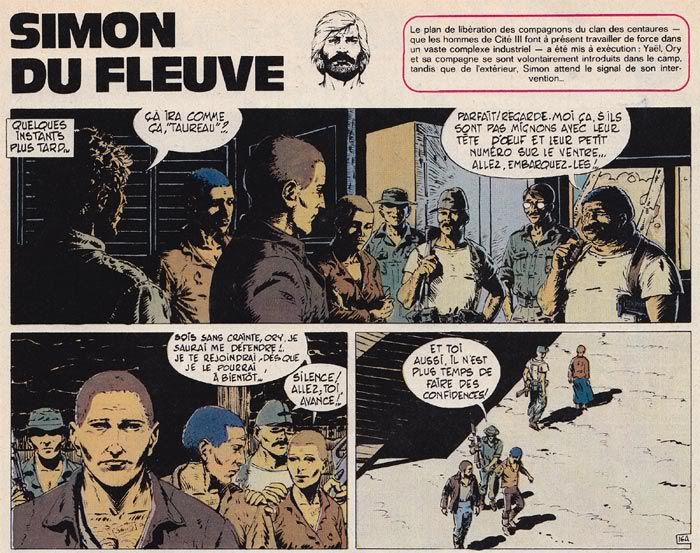 Auclair is a remarkable realistic artist, as can be seen here! 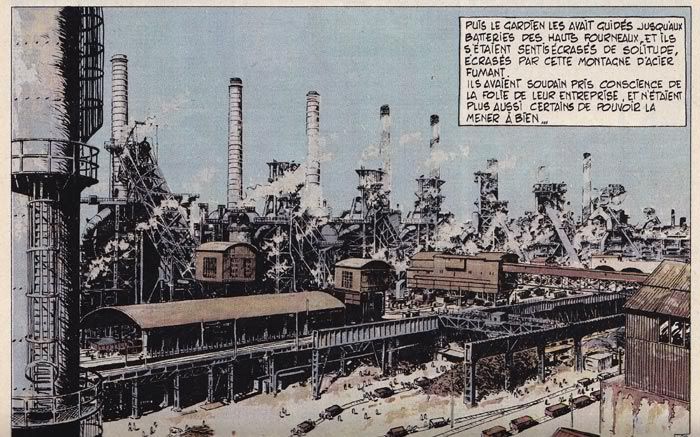 |
|
|
|
Post by Roquefort Raider on Aug 17, 2014 10:56:42 GMT -5
Bruno Brazil is basically "Mission impossible" in comic-book form, written by the omnipresent Greg and drawn by the excellent William Vance. Vance is of course well-known today for his series XIII, but to me he'll always be forst and foremost the defining artist of Bob Morane. In this story, "A storm over the Aleutians", Brazil and his group infiltrate a gang of crooks who smuggle illegal Chinese immigrants into the US, with a sinister purpose : they kill many of their customers before they reach the mainland, and fill the corpses with drugs.  Now THAT's a well-drawn boat! Cosey's Jonathan is still in his first story in this issue. Jonathan is another prize-gathering series; if the Dalai Lama reads only one comic-book series, it's probably this one. It starts as the quest of a young Swiss guy who tries to regain his memory; all he knows is that he's been in Tibet before. He journeys there and finds a tribe of Khambas who had known him before; he then slowly remembers what happened to him. Jonathan, in Switzerland, had met a young Khamba refugee and fallen in love with her; when she went back to her country as a young adult he had followed her. During a Chinese military operation in Tibet, they both had been victims of a bombing raid and the girl had died, while Jonathan was severely concussed. Later episodes would mostly be set in Tibet and Nepal, and go from poetic plots to human drama. It's a very sensitive series, culturally-wise, and avoids the pitfalls of pitting "Good" Tibetans against "Evil" Chinese, while never excusing imperialism.  ![]() Chevalier Ardent Chevalier Ardent is a medieval series by François Craenhals. It's main strength is in its historical verisimilitude, and in its frequent upsetting of the status quo. In this story, Ardent, who is your typical headstrong young knight, has been deprived of his rank and castle by the king, who though he had eloped with his daughter. Furious, the young knight swears revenge on his former liege. (Here, he prepares to gain leadership of a band of robbers). 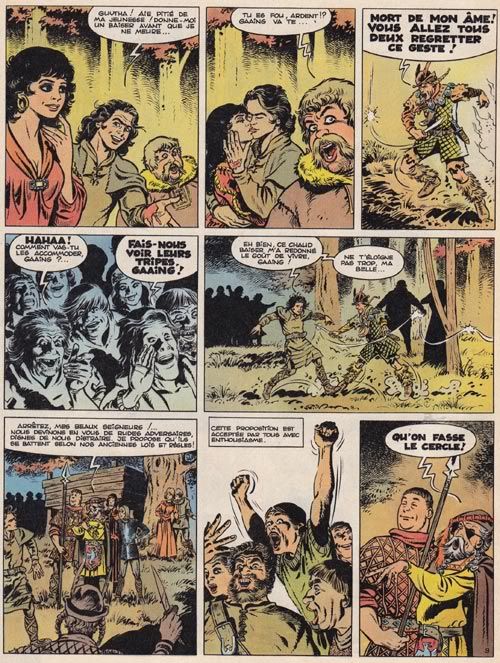
|
|
|
|
Post by Roquefort Raider on Aug 17, 2014 10:58:22 GMT -5
Robin du bois is a Robin Hood spoof. Its creator would have some success with this, but later gain much more reknown with his Leonard series, starring a funny version of Leonardo Da Vinci. 
|
|
|
|
Post by Deleted on Aug 17, 2014 13:14:49 GMT -5
Corto Maltese the Ballad of the Salt Sea is available in English. I know it is one of Shaxper's favorites and based on his recommendations earlier this year, I had our local library order it and read it. It was amazing. IDW recently announced they are doing a new edition of it in English to launch a new line of European translations into English that I will be watching closely. I intend on picking up the new Corto Maltese edition to add to my shelves certainly, and will see what else they do that looks interesting.
-M
|
|
shaxper
CCF Site Custodian
Posts: 22,866
|
Post by shaxper on Aug 17, 2014 20:01:16 GMT -5
Corto Maltese the Ballad of the Salt Sea is available in English. I know it is one of Shaxper's favorites and based on his recommendations earlier this year, I had our local library order it and read it. It was amazing. IDW recently announced they are doing a new edition of it in English to launch a new line of European translations into English that I will be watching closely. I intend on picking up the new Corto Maltese edition to add to my shelves certainly, and will see what else they do that looks interesting. -M I would LOVE to see them translate more Corto Maltese. I actually try not to think about the series now because it drives me insane to know there are so many more stories out there that I can't read. |
|
|
|
Post by fanboystranger on Aug 17, 2014 20:34:21 GMT -5
There was a lot of bad press about the production values of the last big Corto Maltese push into N America. I have that volume of Ballad of the Salt Sea, and I enjoyed it thoroughly. But it was my first time really experiencing Pratt beyond a few isolated pages. I guess there were panels repositioned and omitted and pages completely reconfigured to work within the format. IDW's translations are supposed to be 100% faithful, so I can't wait to get my hands on them.
|
|
|
|
Post by Deleted on Aug 17, 2014 21:32:09 GMT -5
Corto Maltese the Ballad of the Salt Sea is available in English. I know it is one of Shaxper's favorites and based on his recommendations earlier this year, I had our local library order it and read it. It was amazing. IDW recently announced they are doing a new edition of it in English to launch a new line of European translations into English that I will be watching closely. I intend on picking up the new Corto Maltese edition to add to my shelves certainly, and will see what else they do that looks interesting. -M I would LOVE to see them translate more Corto Maltese. I actually try not to think about the series now because it drives me insane to know there are so many more stories out there that I can't read. I wish that big Jericho book would go back in print. I missed out on it and I've been dying to read the series for years, since I bought the first couple issues in floppy format on eBay in or around 2008. From what I can tell the series hasn't been translated in it's entirety or even in any significant amount until these Dark Horse books. I've been wondering about a series that I'm pretty sure is European. I could have read it in Heavy Metal or Epic Illustrated, but it could have also been it's own title from some indy company. Pretty sure it was translated in the 80's or earlier. About a female warrior who operates a tank, or steals a tank, something. In a post apocalyptic desert wasteland type setting. Not Tank Girl, this has more realistic art, in color (I think) and beautifully illustrated. I think I read the second chapter of a long serialized story. Anyone know what I'm talking about? |
|
|
|
Post by berkley on Aug 17, 2014 23:05:41 GMT -5
I think he's currently working at least on the Scorpion (though it's been a while since the last issue) and the Eagles of Rome (written by Marini himself BTW). Edit: And the Scorpion is written by Desberg, who is a remarkably better writer than Thierry (writer on Gypsy), though I tend to find him pretty uneven (loved his Gaspard de la Nuit, hated his I.R.$.). For Dufaux (writer on Raptors), my feelings are about the same; quite diverse writer both in subject as in quality. Thanks. I must admit that both Gypsy and Raptors are memorable to me mostly because of Marini's artwork. I did like one of the female villains in Gypsy; forget her name, but I found her more interesting than the title character himself! Raptors, I've only read the 3rd volume, so I never really got a handle on the story or the characters. Once aging, though, such gorgeous artwork from Marini. (sorry, still haven't figured out the multi-quote function). I really like the concept behind this one and the realistic art looks beautiful. What happened to the other European comics thread - wasn't it merged into this one? I was looking for something the other day that I think was posted there - a recommendation of where to start with Franka, or a description of how and when in the series the artist's style changed, or something like that. |
|
|
|
Post by berkley on Aug 17, 2014 23:18:17 GMT -5
One of our European members talked about Franka on the old board and seeing this reminds me that it's something I've been meaning to try. According to wiki, the artwork changed quite a bit from the earlier volumes before it settled into the style we see here - does anyone know at which point in the series that happened? That probably was me. Problem is that I don't think it was translated that much. Artwise probably between issue 6 and 7, storywise, I think around issue 9 it really takes off. Also after issue 7 the art still changes. Ah, found it! This thread, I mean. I forgot to ask this earlier: when you say issue 9, etc, you're referring to the original Netherlands series, right? So issue 9 would be (according to wiki) "Moordende Concurrentie" or the French issue 6, "Victime de la mode" - is that correct? |
|
|
|
Post by Deleted on Aug 18, 2014 0:14:08 GMT -5
What happened to the other European comics thread - wasn't it merged into this one? I was looking for something the other day that I think was posted there - a recommendation of where to start with Franka, or a description of how and when in the series the artist's style changed, or something like that. They hadn't been merged, as you found, but they should have been, so upon seeing your note, I did merge them. Thanks for the heads up. I am fascinated by European comics, but both threads served essentially the same purpose-to highlight European stuff we may not have seen before, so I combined them. -M |
|
|
|
Post by foxley on Aug 18, 2014 2:34:24 GMT -5
I haven't read Gypsy but I am told that one of the female villains in Gypsy is a near-twin of Mejai, one of the central characters in The Scorpion: a gypsy assassin who starts off trying to kill the hero but who is forced to reluctantly ally herself with him.
|
|
|
|
Post by Dizzy D on Aug 18, 2014 3:51:04 GMT -5
That probably was me. Problem is that I don't think it was translated that much. Artwise probably between issue 6 and 7, storywise, I think around issue 9 it really takes off. Also after issue 7 the art still changes. Ah, found it! This thread, I mean. I forgot to ask this earlier: when you say issue 9, etc, you're referring to the original Netherlands series, right? So issue 9 would be (according to wiki) "Moordende Concurrentie" or the French issue 6, "Victime de la mode" - is that correct? Moordende COncurrentie is the one. |
|
|
|
Post by Rob Allen on Aug 18, 2014 15:07:40 GMT -5
Thanks for the Hugo Pratt pages! That's more Pratt than I've ever seen before. At first the art reminded me of Joe Kubert, then Alex Toth, and then Pat Boyette. I hope there's more available in English soon!
|
|